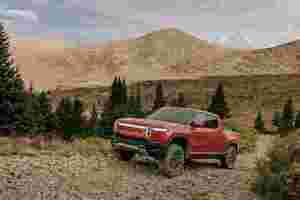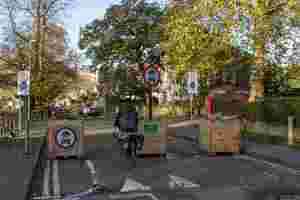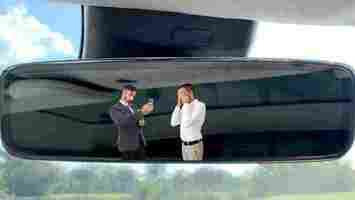Tesla’s biggest Cybertruck competitor just rolled out the largest IPO this year
Rivian today showed that people “will come” even before you build it. Today, the electric truck manufacturer raised a massive $11.9 billion in its initial public offering (IPO). This is the biggest so far this year and the sixth-largest ever on a US exchange. It trumps Uber which raised $8.1 billion in 2019.

The company, founded in 2009, is now valued at more than $77 billion — nearly as much as traditional companies Ford and General Motors. It was briefly valued at $104 billion after trading began.
Shares were offered at $78 each — above the previously estimated price between $57 and $62, showing there’s a keen commitment to buy. Pretty good for a company with almost no revenue from actual vehicle sales.
I spoke to Maxim Manturov, Head of Investment Research at Freedom Finance Europe, just before the IPO, who explained:
Entering a dominant market: How does Rivian stack up against its two main rivals?


Ford will be releasing its F-150 Lightning truck in 2022, and like the Rivian R1T , it also has a 480km driving range. But the F-150 is over $20k cheaper than Rivian. So far, the F-150 has secured 120,000 reservations.
Further, Tesla’s cybertruck has a reported reservation backlog of a massive 1.3 million and will cost consumers between $40,000 and $78,000 — the latter with all the bells and whistles.
Rivan Fleet is no longer exclusive to vans for Amazon
Besides news of a sexual discrimination lawsuit against Rivian last week, the company launched the Fleet section of its website on Friday . This is despite a previously exclusive deal with Amazon for van manufacturing.
It also plans to sell the R1T electric pickup truck and R1S electric SUV in fleets with a corresponding fleet management platform called FleetOS and a charging infrastructure solution.
Manufacturing is slow – can they keep up with demand?
Of course, the challenge will be if Rivian can keep manufacturing up with an influx of orders, especially given the supply chain problems and semiconductor shortage affecting the whole auto industry.
Rivian’s filing with the Security and Exchange Commission reveals worrying manufacturing numbers:
These numbers are woeful considering that Rivian plans to deliver an order of 100,000 electric delivery vans in the next three years, with only 10 delivered by the end of 2021.
Rivian only started delivering the R1T to primarily employees in September and plans to only make about 1,200 vehicles by the end of the year.
According to the IPO filing, its plant in Normal, Illinois, can produce up to 150,000 vehicles annually. The company plans to ramp up to 200,000 vehicles by 2023.
The securities filing also revealed that Amazon holds a 20% stake in Rivian Automotive. The behemoth has more than $1.3 billion in Rivian to date. It’s likely they’ll honor these orders first.
Can Rivian stand up against the brand that is Elon Musk?
Manturov also said that brand recognition might prove to be a challenge for Rivian against its rivals:
Rivian hasn’t got a celebrity CEO. But today’s news shows a firm commitment to electric vehicle manufacturing. It’s a bonus for sustainable mobility.
Study: Low-traffic neighborhoods in London are making roads 3 times safer
When the coronavirus pandemic took hold in March last year, office workers swiftly pivoted to working from home. As travel restrictions came into force, more people were forced to spend time at their homes and in their local community.

In an attempt to make inner city residential communities more liveable, councils began introducing low-traffic neighborhoods. Low-traffic neighborhoods seek to make roads a safer place for all, by limiting the volume of cars allowed on certain residential roads, and improving support for more vulnerable road users like pedestrians and cyclists.
According to a study of London’s Waltham Forest area, researchers found that low-traffic neighborhoods make the roads safer not just for pedestrians, but also cyclists, and drivers. They say low-traffic neighborhoods experienced a three-fold reduction in injuries, compared to areas outside the traffic-calmed area.
Researchers say that walking, cycling, and driving all became between three and four times safer within the low-traffic area.


The study also found that there was no adverse affect to road safety on the edges and boundary roads of the neighborhood.
With low-traffic neighborhoods making the roads safer for all road users, it seems like the obvious next step in the reconfiguration of our cities.
SHIFT is brought to you by Polestar. It’s time to accelerate the shift to sustainable mobility. That is why Polestar combines electric driving with cutting-edge design and thrilling performance. Find out how .
Why Tesla’s in-car monitoring camera is a major privacy risk
A consumer advice magazine from the US is raising fresh concerns over how electric carmaker Tesla uses cameras on its vehicles. This time, it’s the driver and passenger monitoring (in-cabin) camera that’s in the spotlight.

The concerns stem from the fact that Tesla is using a conventional video camera, rather than infrared alternatives that other carmakers use (but more on that later).
“Any time video is being recorded, it can be accessed later,” senior counsel at the Electronic Privacy Information Center, John Davisson, told Consumer Reports .
“There may be legal protections around who can access it and how, but there’s always the possibility that insurance companies, police, regulators, and other parties in accidents will be able to obtain that data.”
The in-cabin camera is located in the rearview mirror of the Model 3 and Model Y. It’s disabled by default, but if switched on it will capture and share video clips of the moments before an accident or when automatic braking is engaged.
Elon Musk has previously said that the camera is there for when Teslas are fully autonomous, and will be taking passengers for taxi rides . But we know that’s a long, long way off, so it seems a little premature.
So, it begs the question of what Tesla might do with this data if one of its cars is involved in a crash.
Suppose the driver is using Autopilot at the time, and is on their phone rather than looking at the road. Will Tesla use the video to prove the driver wasn’t paying attention, and therefore its Autopilot system wasn’t at fault? Your guess is as good as mine.
Other carmakers have in-car cameras for monitoring drivers, so what about their systems?
Good question. Indeed, other car brands do use devices for monitoring drivers to make sure they’re paying attention to the road.
However, those systems use infrared cameras and don’t record any video. They work in real-time, and aren’t storing any data.
While Tesla’s camera is aimed at the driver and their passengers, it’s not a true driver monitoring system. Rather it seems to be more of a surveillance or evidence gathering tool, than a safety feature.
The only driver monitoring system present in Tesla’s vehicles is the torque sensor on the steering wheel, which was once hacked with an orange .
Tesla has previously blamed drivers for not paying attention to the road, when vehicles have crashed with Autopilot engaged.
It’s not a huge leap to assume that Tesla would use video footage to indemnify itself of any responsibility when such incidents occur.
And we haven’t even considered the notion of someone hacking the camera remotely to spy on your whilst driving. It might be worth putting a bit of tape over that little lens piece for now.
Do EVs excite your electrons? Do ebikes get your wheels spinning? Do self-driving cars get you all charged up?
Then you need the weekly SHIFT newsletter in your life. Click here to sign up .